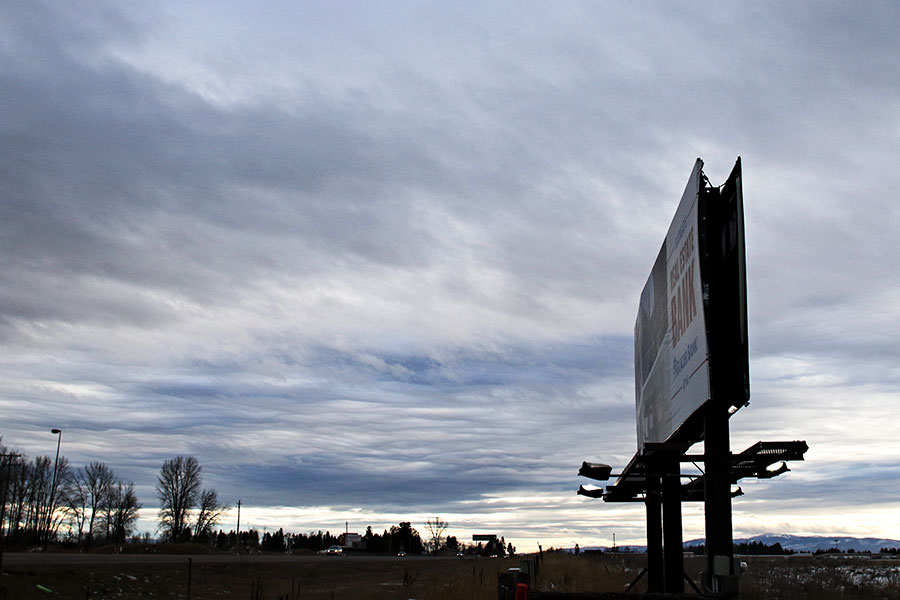Zoning Rule to Protect Scenic Corridors Goes Unchanged
Proposed amendments received strong pushback, would have allowed billboards on numerous highway corridors in the Flathead Valley
By Tristan Scott
The prospect of the Flathead Valley’s scenic highway corridors bristling with billboards drew a standing-room crowd to Thursday’s Flathead County Commission meeting, but residents were overwhelmingly supportive when planning officials said they would not alter a rule designed to protect the area’s scenic highway corridors from the proliferation of unsightly signs.
Tasked with adjusting local zoning regulations and tweaking language through text amendments as a means to make the complex set of planning rules more consistent and accessible to the public, Flathead County Planning Director Mark Mussman explained that the proposed change to the scenic corridor overlays was born of a 2015 U.S. Supreme Court decision, Reed v. the Town of Gilbert, Ariz., in which the court ruled in favor of a community church’s signs advertising worship times around town in spite of a sign ordinance barring them, dramatically expanding free speech protections to non-commercial signage.
Still, faced with a groundswell of concern from community members and a deluge of written comments, Mussman said he decided to retain the current sign ordinance unchanged.
“The intent was to not be in a position where it could be viewed that we were regulating content. But we are just going to take our chances that we don’t get challenged” for First Amendment violations in court, he said after the meeting.
Whitefish Planning Director Dave Taylor, a vocal critic of the proposed changes, said the amendment would have allowed off-premise signs and billboards up to 250 square feet in the scenic corridor overlay zones where they are currently banned entirely. Those scenic corridor zones follow Highway 93 from Whitefish to Lincoln County; from Kalispell to Lakeside; Highway 40 between Whitefish and Columbia Falls; the North Fork road; and Highways 2, 35, and 206.
“It had the potential to vastly change the aesthetics of the Flathead Valley,” Taylor said. “I commend you on maintaining the scenic overlay the way it is. I think it’s really an important step toward maintaining the aesthetic of these scenic corridors.”
The Flathead County Planning Board proposed the set of text amendments to current zoning regulations because much of the language has become outmoded, and also to realign the regulations with the numerous goals and policies of the Flathead County Growth Policy.
“Seventy to 80 percent of what we’re proposing here is just to clean it up and update it and keep it consistent,” Mussman said of the zoning regulations. “It’s for ease of administration. I think a lot of people in this room will be pleased to learn that the language prohibiting off-premise signs in the designated scenic corridor overlays will remain.”
An overlay or standing district is intended to protect the scenic vistas and provide greater traffic safety along the highway corridors by restricting the number, size and location of outdoor advertising signs and billboards. This district can function as a standing district or can be applied to zoned areas. If zoned, this district will only regulate off-premise advertising signs, meaning signs that advertise a business that does not reside on the property.
Before adjourning, the commission voted to remove the proposed changes to the scenic corridor overlays from the set of text amendments, and also voted to take the proposed changes that remain under advisement while they consider public comment.
Although the majority of the comments centered on the scenic corridors, other concerns ranged from short-term rentals and their impact on the affordable-housing market; multiple principal and permitted uses on a single lot; and meeting the goals and policies of both the Flathead County and Whitefish growth policies.
Erica Wirtala, of the Northwest Montana Association of Realtors, said the region’s scenic highway corridors are a boon to real estate sales.
“Our realtors sell those view sheds every day,” she said.
Sharon DeMeester served on the citizens group that fought to create the scenic corridor overlays, and said the corridors would only continue to shrink if left unprotected.
“I really appreciate you trying to maintain our scenic corridors,” she said. “It is critical to this area’s vitality.”
Billboards approved prior to the sign ordinance are grandfathered in.